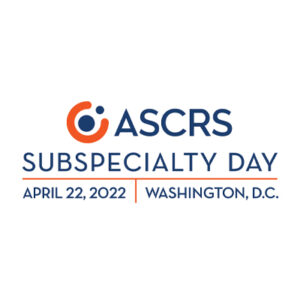ASCRS News
June 2022
by David F. Chang, MD
The Ophthalmic Instrument Cleaning & Sterilization (OICS) Task Force is comprised of representatives from the American Society of Cataract and Refractive Surgery (ASCRS), the American Academy of Ophthalmology (AAO), the American Glaucoma Society (AGS), and the Outpatient Ophthalmic Surgery Society (OOSS), and previously developed ophthalmology-specific guidelines for surgical instrument processing and sterilization.1 Co-chaired by Cathleen McCabe, MD, and myself, the Task Force is also focused on reducing operating room waste, which significantly increases the cost and carbon footprint of ophthalmic surgery.
Documenting the policies of multiple regulatory and accreditation agencies, this evidence-based paper clarifies that multidose bottles can be used on multiple patients and need not be arbitrarily discarded at the end of the day, the week, or the month.
In a 2020 survey by the OICS Task Force, 93% of ophthalmologists thought that operating room waste was excessive.2 Almost all (98%) were using or were willing to consider using multidose bottles of topical medication for multiple cataract patients. However, less than half were using multidose bottles for topical anesthetic (43%), mydriatics (48%), NSAIDs (38%), and antibiotics (45%). In a subsequent sub-analysis, those using multidose bottles on multiple patients were much more likely to be operating in ambulatory surgery centers (ASCs) than in hospital outpatient departments (52% vs. 19% using multidose mydriatic drops).3 A separate survey of OOSS member ASCs was conducted by the OICS Task Force in 2021. Most ASCs were using multidose bottles on multiple patients, but only 12% said they continued utilizing them until the labeled expiration date; others were discarding the bottles at the end of the day (9%), the week (3%), or the month (72%).
These two surveys revealed wide variation in whether multidose bottles are reused on multiple surgical patients, and if so, for how long. This is important because surgical drugs account for a significant proportion of cataract surgery’s cost and carbon footprint. A 2019 study analyzed the economic and environmental impact of medication waste at four cataract surgical facilities.4 Based on their analysis, the researchers projected that drug waste costs approximately $150 per case and generated 23,000 to 105,000 metric tons of unnecessary CO2 equivalent emissions annually in the U.S.
An OICS subcommittee led by David Palmer, MD, and Alan Robin, MD, researched the regulations regarding multidose bottles by contacting multiple agencies, including The Joint Commission, the Accreditation Association for Ambulatory Health Care, the American Association for Accreditation of Ambulatory Surgery Facilities, the Centers for Disease Control and Prevention, the U.S. Food and Drug Administration (FDA), and the Centers for Medicaid & Medicare Services (CMS). Following discussions with the Task Force, Wiley Chambers, MD, director of the FDA Office of Specialty Medicine, Division of Ophthalmology, wrote a supportive editorial on reducing drug waste.5 These agencies were consistent in permitting surgical facilities to use topical drugs in multidose containers on multiple patients until the manufacturer’s labeled date of expiration, assuming that proper guidelines are followed. The OICS Task Force specifically asked CMS to clarify to its surveyors that multidose eye drop bottles are not subject to the 28-day expiration policy that applies to injectable solutions. As part of their collaboration with our Task Force, the American Society of Ophthalmic Registered Nurses (ASORN) published an updated multidose eye drop application protocol on its website.6
Dr. Palmer previously led efforts to enact legislation in Illinois to enable surgical patients to bring partially used topical medication home for postoperative use, when appropriate. In 2021, the American Medical Association House of Delegates unanimously adopted a modification of the Illinois resolution titled “Permitting the Dispensing of Stock Medications for Post-Discharge Use and the Safe Use of Multidose Eyedrops on Multiple patients,” which had been endorsed by multiple specialty societies, including AAO, ASCRS, AGS, and ASORN.
The OICS Task Force distilled its research into a position statement with three recommendations to reduce unnecessary drug waste with ophthalmic surgery (see box). Endorsed by ASCRS, AAO, AGS, and OOSS, this document was released on April 6, and was posted on each society’s website and on EyeSustain.org. Documenting the policies of multiple regulatory and accreditation agencies, this evidence-based paper clarifies that multidose bottles can be used on multiple patients and need not be arbitrarily discarded at the end of the day, the week, or the month. The paper also stated the Task Force consensus that surgical patients requiring a topical medication not used for other patients should be allowed to bring that partially used medication home for postoperative use.
article sidebar
Recommendations endorsed by ASCRS, AAO, AGS, and OOSS
- Topical drugs in multidose containers can be used on multiple patients in surgical facilities if proper guidelines are followed.
- Topical drugs in multidose containers can be used until the manufacturer’s labeled date of expiration if proper guidelines are followed.
- When applicable, patients should be able to bring their partially used medication home for postoperative use.
References
- Chang DF, Mamalis N, Ophthalmic Instrument Cleaning and Sterilization Task Force. Guidelines for the cleaning and sterilization of intraocular surgical instruments. J Cataract Refract Surg. 2018;44;765–773.
- Chang DF, Thiel CL, Ophthalmic Instrument Cleaning and Sterilization Task Force. Survey of cataract surgeons’ and nurses’ attitudes toward operating room waste. J Cataract Refract Surg. 2020;46:933–940.
- Theil CL, et al. Differences in reuse of cataract surgical supplies and pharmaceuticals based on type of surgical facility. J Cataract Refract Surg. 2022. Online ahead of print.
- Tauber J, et al. Quantification of the cost and potential environmental effects of unused pharmaceutical products in cataract surgery. JAMA Ophthalmol. 2019;137;1156–1163.
- Chambers WA. Waste no more. Ophthalmology. 2021;128:1667–1668.
- American Society of Ophthalmic Registered Nurses. Recommended practice for registered nurses: use of multi-dose medications. Accessed March 11, 2022. asorn.org/professional-resources/policies-and-recommendations/asorn-recommended-practice-use-of-multi-dose-medications/.
Contact
Chang: dceye@earthlink.net



